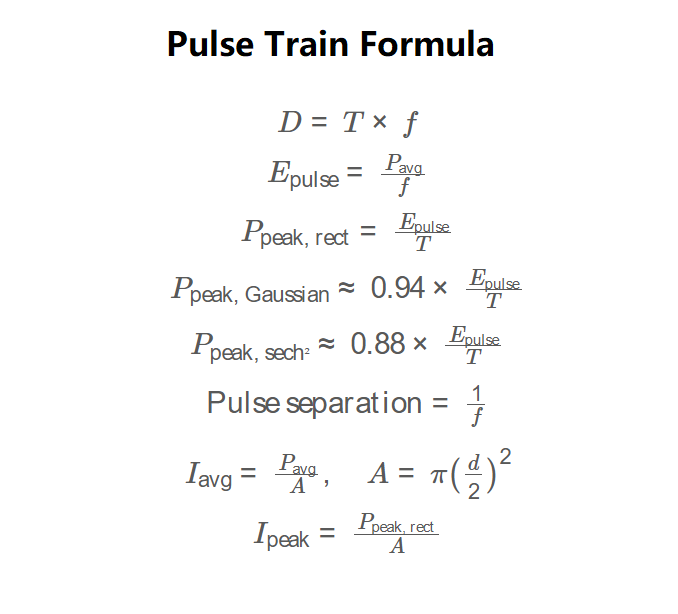 Home
Home
 Back
Back

Definition: This calculator computes key properties of an optical pulse train, including duty cycle, pulse energy, peak powers (for rectangular, Gaussian, and sech² pulse shapes), pulse separation, and intensities (average and peak), based on pulse duration, repetition rate, average power, and spot diameter.
Purpose: Researchers, engineers, and laser technicians use this tool to analyze pulsed laser performance, optimize laser systems for applications like material processing, medical procedures, and scientific research, and ensure safe operation by calculating intensities.
The calculator uses the following formulas, as shown in the image above:
\( D = T \times f \)
\( E_{\text{pulse}} = \frac{P_{\text{avg}}}{f} \)
\( P_{\text{peak, rect}} = \frac{E_{\text{pulse}}}{T} \)
\( P_{\text{peak, Gaussian}} \approx 0.94 \times \frac{E_{\text{pulse}}}{T} \)
\( P_{\text{peak, sech²}} \approx 0.88 \times \frac{E_{\text{pulse}}}{T} \)
\( \text{Pulse separation} = \frac{1}{f} \)
\( I_{\text{avg}} = \frac{P_{\text{avg}}}{A}, \quad A = \pi \left(\frac{d}{2}\right)^2 \)
\( I_{\text{peak}} = \frac{P_{\text{peak, rect}}}{A} \)
Where:
Steps:
Calculating pulse train properties is critical for:
Example 1: Calculate the pulse train properties for a laser with pulse duration 100 ns, repetition rate 1 kHz, average power 1 W, spot diameter 1 mm, outputting duty cycle in %, pulse energy in mJ, peak power in kW, pulse separation in ms, average intensity in kW/m2, and peak intensity in MW/m2:
Example 2: Calculate the pulse train properties for a laser with pulse duration 500 fs, repetition rate 1 MHz, average power 500 mW, spot diameter 50 um, outputting duty cycle in decimal, pulse energy in uJ, peak power in MW, pulse separation in us, average intensity in MW/m2, and peak intensity in GW/m2:
Q: Why are there different peak powers for rectangular, Gaussian, and sech² pulses?
A: The peak power depends on the pulse shape. Rectangular pulses assume a constant power over the duration, while Gaussian and sech² pulses have smoother profiles, reducing the peak power by factors of 0.94 and 0.88, respectively.
Q: Why can I select different units for each output?
A: Independent unit selection allows flexibility for different applications, where users might prefer pulse energy in uJ for low-energy pulses, peak power in MW for high-power lasers, or intensities in GW/m2 for nonlinear optics.
Q: What does a duty cycle greater than 1 mean?
A: A duty cycle greater than 1 is not physically possible for a pulsed laser, as it implies overlapping pulses. The calculator will flag this as an error.